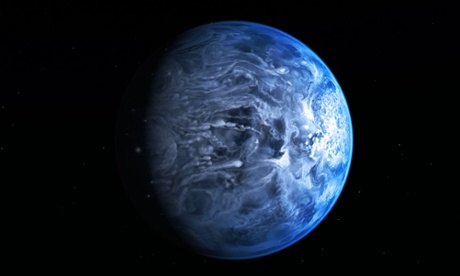Science
Related: About this forumAlien 'deep blue' planet discovered

An artist's impression of the blue planet, which is a gas giant. The same technique could be used to identify habitable worlds. Image: Nasa
The heavens are home to an alien world that shines a deep cobalt blue in a solar system far, far away from our own.
Astronomers used the ageing Hubble space telescope to determine the true hue of the distant world, the first time such a feat has been achieved for a planet that circles a star other than the sun.
Unlike the pale blue dot that harbours all known life in the cosmos, the "deep blue dot" is an inhospitable gas giant that lies 63 light years from Earth. On HD189733b, as the planet is named, the temperature soars to 1,000C and glassy hail whips through the air on hypersonic winds.
Though the planet is hostile to life as we know it, the same technique could be used to spot potentially habitable worlds, through changes in cloud cover and other features.
Frederic Pont at Exeter University observed the planet before, during, and after it passed behind its star. When the planet was on either side, the telescope collected light from the star along with light reflected from the planet's surface. But as the planet moved behind the star, the light it reflected was blocked out.
more
http://www.guardian.co.uk/science/2013/jul/11/alien-deep-blue-planet-astronomers
JDPriestly
(57,936 posts)DreamGypsy
(2,252 posts)The NASA press release which presumably was the basis for the Guardian article.
The content of the press release is similar, but I found a couple of NASA's explanations a bit more detailed and clear.
<snip>
On this turbulent alien world, the daytime temperature is nearly 2,000 degrees Fahrenheit, and it possibly rains glass -- sideways -- in howling, 4,500-mph winds. The cobalt blue color comes not from the reflection of a tropical ocean as it does on Earth, but rather a hazy, blow-torched atmosphere containing high clouds laced with silicate particles. Silicates condensing in the heat could form very small drops of glass that scatter blue light more than red light.
HD 189733b is among a bizarre class of planets called hot Jupiters, which orbit precariously close to their parent stars. The observations yield new insights into the chemical composition and cloud structure of the entire class.
Clouds often play key roles in planetary atmospheres. Detecting the presence and importance of clouds in hot Jupiters is crucial to astronomers' understanding of the physics and climatology of other planets.
HD 189733b was discovered in 2005. It is only 2.9 million miles from its parent star, so close that it is gravitationally locked. One side always faces the star and the other side is always dark.
In 2007, NASA's Spitzer Space Telescope measured the infrared light, or heat, from the planet, leading to one of the first temperature maps for an exoplanet. The map shows day side and night side temperatures on HD 189733b differ by about 500 degrees Fahrenheit. This should cause fierce winds to roar from the day side to the night side.
A lot of information and history about HD 189733b is also available on Wikipedia, eg. the planet was discovered in 2005.
Thanks for the post, n2doc. I first encountered the blue planet on an MSN science and tech story, then tracked down the NASA press release. I was going to post, but searched first for "189733b" and found your thread.
eppur_se_muova
(36,269 posts)For the first time, astronomers have determined the true colour of a planet orbiting another star.
The world, known as HD189733b, has a deep azure hue - probably the result of silicate (glass) rain in the atmosphere, which scatters blue light.
Details of the discovery, made with the Hubble Space Telescope, are to appear in Astrophysical Journal Letters.
Although it might resemble Earth from a distance, HD189733b is a huge gas giant which orbits close to its host star.
The temperature of the planet's atmosphere is a scorching 1,000C, and it rains glass, sideways, in howling 7,000km-per-hour winds.
***
more: http://www.bbc.co.uk/news/science-environment-23275607
full paper: http://www.spacetelescope.org/static/archives/releases/science_papers/heic1311.pdf
Didn't Prince do a song about this ? ![]()